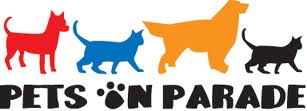 The Children’s Literature and Reading SIG is bringing Part 2 to our animal reviews this week. Last week we presented animals in the wild, so this week’s theme deals with pets and domestic animals. As children learn to take care of a pet or learn to deal with some of the less endearing parts of a pet these books might bring some solutions or helpful ideas. Children will also read about rescue dogs and animal shelters. At the same time, there are so many funny things about pets and appreciating their loyalty that authors have created wonderful stories, both fact and fiction, to bring to young readers.
The Children’s Literature and Reading SIG is bringing Part 2 to our animal reviews this week. Last week we presented animals in the wild, so this week’s theme deals with pets and domestic animals. As children learn to take care of a pet or learn to deal with some of the less endearing parts of a pet these books might bring some solutions or helpful ideas. Children will also read about rescue dogs and animal shelters. At the same time, there are so many funny things about pets and appreciating their loyalty that authors have created wonderful stories, both fact and fiction, to bring to young readers.
Listen to ReadWriteThink’s podcast entitled “Unusual Pets” for other book recommendations on animals or the RWT lesson idea using Comic Creator for lots of animal possibilities or the lesson plan idea for April and Poetry Month that combines poetry and animals at “Help a Child Write a Poem.”
Plus, the Engage blog has a delightful story called "Bringing Children, Dogs, and Books Together."
Use some of the videos found at The Animal Planet website for media literacy plans and books for even more animal ideas.
GRADES K-2
Arlon, Penelope. (2013). Scholastic Discover More: Puppies and kittens. New York: Scholastic.
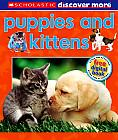 Undoubtedly, there's nothing cuter than a puppy or a kitten—unless it's a litter of the adorable creatures. This book contains plentiful colorful photographs of these cuddly baby animals, sometimes alongside their equally appealing mothers. The book’s thirteen chapters provide information about the particular needs of puppies and kittens when they are newborn and then as they grow. Although some of these facts are well-known, not all of them are. For instance, while kittens can purr when they are only two days old, puppies cannot bark until they are two to four weeks old. The book also contains chapters explaining how puppies and kittens need to play and suggesting toys and games to play with them. This engaging text may encourage readers to visit their local animal shelter to offer a forever home to a new furry friend.
Undoubtedly, there's nothing cuter than a puppy or a kitten—unless it's a litter of the adorable creatures. This book contains plentiful colorful photographs of these cuddly baby animals, sometimes alongside their equally appealing mothers. The book’s thirteen chapters provide information about the particular needs of puppies and kittens when they are newborn and then as they grow. Although some of these facts are well-known, not all of them are. For instance, while kittens can purr when they are only two days old, puppies cannot bark until they are two to four weeks old. The book also contains chapters explaining how puppies and kittens need to play and suggesting toys and games to play with them. This engaging text may encourage readers to visit their local animal shelter to offer a forever home to a new furry friend.
- Barbara A. Ward, Washington State University Pullman
Breen, Steve. (2013). Pug & Doug. New York: Dial Books for Young Readers.
 Author/illustrator Steve Breen is a Pulitzer Prize-winning author who has turned his talents to writing a tale of friendship. Pug and Doug are good friends though very different from each other. They share a secret “pawshake” and a love of donuts, but their personalities take different directions. Doug is artistic and creative and Pug is organized and likes things done correctly in order. It appears that Pug is starting to drift away from Doug, and Doug is worried about their friendship. When Pug realizes what has happened and a birthday surprise is in the works, the two friends reunite and find their friendship stronger than ever. Pastel watercolors, colored pencils and mixed media bring a color palette to the story that brings out the differences in color, and people, but represents how they can be blended to make a beautiful picture.
Author/illustrator Steve Breen is a Pulitzer Prize-winning author who has turned his talents to writing a tale of friendship. Pug and Doug are good friends though very different from each other. They share a secret “pawshake” and a love of donuts, but their personalities take different directions. Doug is artistic and creative and Pug is organized and likes things done correctly in order. It appears that Pug is starting to drift away from Doug, and Doug is worried about their friendship. When Pug realizes what has happened and a birthday surprise is in the works, the two friends reunite and find their friendship stronger than ever. Pastel watercolors, colored pencils and mixed media bring a color palette to the story that brings out the differences in color, and people, but represents how they can be blended to make a beautiful picture.
- Karen Hildebrand, Ohio Library and Reading Consultant
Crow, Melinda Melton. (2013). Rocky and Daisy at the Park. Illus. by Mike Brownlow. Mankato, MN: Stone Arch Books/Capstone Press.
 From the Stone Arch Readers series for emerging readers, Owen is a young boy with two dogs that like to do different things. One is more quiet and playful while the other is rambunctious and ready to run. This presents a problem for Owen when he is trying to take them for a walk or play with them in the yard. When his parents suggest trying the dog park, it brings a whole new experience for everyone that includes a great deal of fun, or not, in the mud. This early reader chapter book provides a story that many young children can identify with concerning their pets.
From the Stone Arch Readers series for emerging readers, Owen is a young boy with two dogs that like to do different things. One is more quiet and playful while the other is rambunctious and ready to run. This presents a problem for Owen when he is trying to take them for a walk or play with them in the yard. When his parents suggest trying the dog park, it brings a whole new experience for everyone that includes a great deal of fun, or not, in the mud. This early reader chapter book provides a story that many young children can identify with concerning their pets.
- Karen Hildebrand, Ohio Library and Reading Consultant
Helakoski, Leslie. (2013). Doggone feet! Honesdale, PA: Boyds Mills Press.
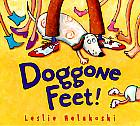 A loyal dog that is quite attached to her human companion describes how her life has changed ever since she went home from a park with the person she knows as Legs. Life is pretty good, but eventually she grudgingly manages to make room for other residents, including one that insists on the dog being shampooed and one that throws meat onto the floor. As time moves on, her small family grows to encompass one, two, three, four, and even more additions. Young readers will enjoy the surprise at the end as well as the endpapers covered with the tracks of various individuals. Because readers don't see the upper half of the humans until near the end of the book, the dog's point of view is enhanced. Having the illustrations and the text originate from a dog's perspective adds to this book’s uniqueness. Learn how the book trailer was made for Doggone Feet or check out the detailed activity guide based on the Common Core State Standards at the author’s website.
A loyal dog that is quite attached to her human companion describes how her life has changed ever since she went home from a park with the person she knows as Legs. Life is pretty good, but eventually she grudgingly manages to make room for other residents, including one that insists on the dog being shampooed and one that throws meat onto the floor. As time moves on, her small family grows to encompass one, two, three, four, and even more additions. Young readers will enjoy the surprise at the end as well as the endpapers covered with the tracks of various individuals. Because readers don't see the upper half of the humans until near the end of the book, the dog's point of view is enhanced. Having the illustrations and the text originate from a dog's perspective adds to this book’s uniqueness. Learn how the book trailer was made for Doggone Feet or check out the detailed activity guide based on the Common Core State Standards at the author’s website.
- Barbara A. Ward, Washington State University Pullman
Himmelman, John. (2013). Katie and the puppy next door. New York: Henry Holt/Macmillan.
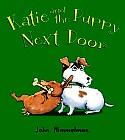 Pen and watercolor illustrations bring young readers the story of Katie, the terrier, and her new neighbor, the dachshund, Ruby. Katie’s life has been very good with her owner Sara Ann and the three cats and chew toys enjoyed by all. But when Ruby dashes into their lives and chews Katie’s favorite toys and makes friends with HER cats, Katie is not overjoyed at this neighborliness. However, Sara Ann would very much like for Katie to learn to share. When a tug of war breaks out over toys and cats, Katie learns that this situation can actually be fun. Though the obvious story line is about dogs and cats, the underlying message here very definitely relates to young children and teachers will enjoy this book as a read aloud and discussion starter for young readers.
Pen and watercolor illustrations bring young readers the story of Katie, the terrier, and her new neighbor, the dachshund, Ruby. Katie’s life has been very good with her owner Sara Ann and the three cats and chew toys enjoyed by all. But when Ruby dashes into their lives and chews Katie’s favorite toys and makes friends with HER cats, Katie is not overjoyed at this neighborliness. However, Sara Ann would very much like for Katie to learn to share. When a tug of war breaks out over toys and cats, Katie learns that this situation can actually be fun. Though the obvious story line is about dogs and cats, the underlying message here very definitely relates to young children and teachers will enjoy this book as a read aloud and discussion starter for young readers.
- Karen Hildebrand, Ohio Library and Reading Consultant
Horvath, James. (2013). Dig, dogs, dig: a construction tail. New York: HarperCollins.
 Kids who love trucks and big equipment will enjoy this book. The construction crew consists of a dozen digging dogs and one black cat. They wake up early from their dormitory room and get to work. A busy day waits as they begin the task of building a playground. In rhyming text, the construction equipment and heavy-duty trucks are explained as they begin the excavation until they literally hit a snag. They have hit upon a dinosaur bone! As their work continues they get the playground finished complete with trails and a duck pond and a huge display for the dinosaur bone. The end pages display the crew with their names. Click here for an activity based on this book. Read more about this author and his new book at his website and blog.
Kids who love trucks and big equipment will enjoy this book. The construction crew consists of a dozen digging dogs and one black cat. They wake up early from their dormitory room and get to work. A busy day waits as they begin the task of building a playground. In rhyming text, the construction equipment and heavy-duty trucks are explained as they begin the excavation until they literally hit a snag. They have hit upon a dinosaur bone! As their work continues they get the playground finished complete with trails and a duck pond and a huge display for the dinosaur bone. The end pages display the crew with their names. Click here for an activity based on this book. Read more about this author and his new book at his website and blog.
- Karen Hildebrand, Ohio Library and Reading Consultant
Johnson, J. Angelique. (2012). Getting a pet, step-by-step. Mankato, MN: Capstone Press.
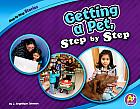 Meet Maggie and her family as they decide what pet is right for their family. Told through full page photographs and text boxes readers will follow Maggie and her family as they go to the pet store looking at different animals and then looking through books to learn even more about a variety of animal choices and their care. When they decide they would like a dog they look online and the newspaper for possible places to purchase their new pet. They decide to visit an animal shelter and there find a dog named Coco. The caretaker at the shelter gives them information about caring for their new dog. They buy a crate and a leash and chew toys and water bowls and all the supplies they will need and then they are ready to bring Coco to his new home.
Meet Maggie and her family as they decide what pet is right for their family. Told through full page photographs and text boxes readers will follow Maggie and her family as they go to the pet store looking at different animals and then looking through books to learn even more about a variety of animal choices and their care. When they decide they would like a dog they look online and the newspaper for possible places to purchase their new pet. They decide to visit an animal shelter and there find a dog named Coco. The caretaker at the shelter gives them information about caring for their new dog. They buy a crate and a leash and chew toys and water bowls and all the supplies they will need and then they are ready to bring Coco to his new home.
- Karen Hildebrand, Ohio Library and Reading Consultant
Kulling, Monica. (2013). Mister Dash and the cupcake calamity. Illus. by Esperanca Melo. Toronto, ON: Tundra Books.
 Madame Croissant is well known for her famously delicious cupcakes. Mr. Dash, a dog with a mixed-breed background, is the dependable deliverer of the cupcakes. One day Madame’s niece, Daphne, arrives to “help” make the cupcakes only Daphne’s idea of helping is ready to drive Madame a little crazy in the kitchen. Sprinkled with delightful French phrases and the bright acrylic paintings of Melo, the fun that ensues might be identifiable to young readers who have also tried to “help” in the kitchen. Madame and Mister Dash sigh a breath of relief at the end of the day when they wave goodbye to Daphne.
Madame Croissant is well known for her famously delicious cupcakes. Mr. Dash, a dog with a mixed-breed background, is the dependable deliverer of the cupcakes. One day Madame’s niece, Daphne, arrives to “help” make the cupcakes only Daphne’s idea of helping is ready to drive Madame a little crazy in the kitchen. Sprinkled with delightful French phrases and the bright acrylic paintings of Melo, the fun that ensues might be identifiable to young readers who have also tried to “help” in the kitchen. Madame and Mister Dash sigh a breath of relief at the end of the day when they wave goodbye to Daphne.
- Karen Hildebrand, Ohio Library and Reading Consultant
Loewen, Nancy. (2012). Good-bye, Jeepers. What to expect when your pet dies. Illus. by Christopher Lyles. Mankato, MN: Picture Window Books/Capstone Press.
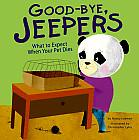 It is never easy to lose a loved one, and often for young children their first experience with death is the loss of their pet. In Good-bye, Jeepers, a young gender-neutral Panda is the main character. (Readers do not know if he is a boy or girl and it doesn’t matter.
The book is intended to reach young children regardless if boy or girl.) As the story opens and the young Panda wakes up on a Saturday morning he discovers that his pet guinea pig has died. His parents talk to him about death and grief and say it’s okay to cry. He feels sad but goes to school and begins to think about other things. When he gets home, his family helps him plan a burial and friends and neighbors help young Panda get through this loss. Throughout the book are subtle text boxes that contain helpful tips about dealing with death and loss. This could be that just right book for that tough moment when children in your classes have lost a beloved pet.
It is never easy to lose a loved one, and often for young children their first experience with death is the loss of their pet. In Good-bye, Jeepers, a young gender-neutral Panda is the main character. (Readers do not know if he is a boy or girl and it doesn’t matter.
The book is intended to reach young children regardless if boy or girl.) As the story opens and the young Panda wakes up on a Saturday morning he discovers that his pet guinea pig has died. His parents talk to him about death and grief and say it’s okay to cry. He feels sad but goes to school and begins to think about other things. When he gets home, his family helps him plan a burial and friends and neighbors help young Panda get through this loss. Throughout the book are subtle text boxes that contain helpful tips about dealing with death and loss. This could be that just right book for that tough moment when children in your classes have lost a beloved pet.
- Karen Hildebrand, Ohio Library and Reading Consultant
Meisel, Paul. (2013). See me dig. New York: Holiday House.
 This new companion to the author’s 2011 book, See Me Run, is another rollicking romp with this pack of digging canines. Their dig this time uncovers a bear and a pretty scary one at that. They run off to the beach and begin another digging adventure in the sand. This time they uncover a treasure chest and are certain it is full of pirate’s gold. Wrong! It is full of pirate something, but it is the ghosts of pirates that chase dogs. The dogs run off again and find a real excavation site complete with a huge clawed bulldozer. This time however, they learn that their digging sites can be shared. Cartoon-like watercolor, pen-and-ink and pencil drawings combined with very simple sentences and vocabulary make this a delightful reading adventure for primary students.
This new companion to the author’s 2011 book, See Me Run, is another rollicking romp with this pack of digging canines. Their dig this time uncovers a bear and a pretty scary one at that. They run off to the beach and begin another digging adventure in the sand. This time they uncover a treasure chest and are certain it is full of pirate’s gold. Wrong! It is full of pirate something, but it is the ghosts of pirates that chase dogs. The dogs run off again and find a real excavation site complete with a huge clawed bulldozer. This time however, they learn that their digging sites can be shared. Cartoon-like watercolor, pen-and-ink and pencil drawings combined with very simple sentences and vocabulary make this a delightful reading adventure for primary students.
- Karen Hildebrand, Ohio Library and Reading Consultant
Panzieri, Lucia. (2013). The kindhearted crocodile. Illus. by AntonGionata Ferrari. New York: Holiday House.
 Teachers looking for a read aloud for Children’s Book Week, El Dia, or other literacy celebrations, this is the book for you. With a storyteller’s style and often using direct nods to the reader, this is the story of a crocodile that would like to become a family pet. He conjures a plan to slip into the pages of the picture book the children are reading and hide there during the day. Each night he sneaks off the pages and into the reality of the family where he sees a multitude of ways he can be of help. He folds laundry and straightens things up around the cluttered house and before he slips back onto the pages of the book, he has breakfast ready for the family. Puzzled, the family stays up one night and hides until they see the crocodile slither out from the pages of the book and discover his secret. Now what to do? A family argument develops about whether to keep this wild toothy creature in their home. The colorful textured illustrations, especially the facial expressions of the croc, add to the humor and fun of this family story. First published in Italy in 2008.
Teachers looking for a read aloud for Children’s Book Week, El Dia, or other literacy celebrations, this is the book for you. With a storyteller’s style and often using direct nods to the reader, this is the story of a crocodile that would like to become a family pet. He conjures a plan to slip into the pages of the picture book the children are reading and hide there during the day. Each night he sneaks off the pages and into the reality of the family where he sees a multitude of ways he can be of help. He folds laundry and straightens things up around the cluttered house and before he slips back onto the pages of the book, he has breakfast ready for the family. Puzzled, the family stays up one night and hides until they see the crocodile slither out from the pages of the book and discover his secret. Now what to do? A family argument develops about whether to keep this wild toothy creature in their home. The colorful textured illustrations, especially the facial expressions of the croc, add to the humor and fun of this family story. First published in Italy in 2008.
- Karen Hildebrand, Ohio Library and Reading Consultant
Prevost, Jeanne. (2013). It’s raining pups and dogs! (Sit! Stay! Read!) Minneapolis: The Gryphon Press.
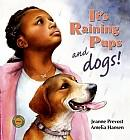 Young Lauren is upset when her father says her female dog will not be allowed to have a litter of pups and in fact, will be spayed. When Scout returns from her surgery, Lauren is mad at her father and sad to think she will never get to raise some puppies. Her father carefully explains to her about the overpopulation of dogs, especially unwanted dogs. To make his point even more real, he takes Lauren to a local animal shelter. The shelter attendant shows Lauren the hundreds of dogs waiting for adoption. The story itself does not go into euthanasia or describing puppy mills, but the author includes these facts at the end of the book. There are not many books available that deal with this subject so frankly and in terms a child can understand. Learn more about the work of Gryphon Press that “exists to bring children beautifully illustrated books about the human-animal bond, books that foster empathy in children for other living beings.”
Young Lauren is upset when her father says her female dog will not be allowed to have a litter of pups and in fact, will be spayed. When Scout returns from her surgery, Lauren is mad at her father and sad to think she will never get to raise some puppies. Her father carefully explains to her about the overpopulation of dogs, especially unwanted dogs. To make his point even more real, he takes Lauren to a local animal shelter. The shelter attendant shows Lauren the hundreds of dogs waiting for adoption. The story itself does not go into euthanasia or describing puppy mills, but the author includes these facts at the end of the book. There are not many books available that deal with this subject so frankly and in terms a child can understand. Learn more about the work of Gryphon Press that “exists to bring children beautifully illustrated books about the human-animal bond, books that foster empathy in children for other living beings.”
- Karen Hildebrand, Ohio Library and Reading Consultant
Rissman, Rebecca. (2013). Should Wendy walk the dog? New York: Raintree.
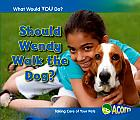 Filled with photographs of the children and their pets, this book contains four different scenarios about choices and their consequences. While Wendy and the other children in the scenarios are free to make their own decisions about whether to do the right thing such as walking the dog or cleaning out the hamster cage, the fact that the book shows two different choices and then the results of those choices is liable to encourage youngsters to make better choices. While all of us would rather be lazy at times rather than doing our work, in the end we may be sorry and we may have created more work for ourselves. This book will prompt some good conversations between adults and children.
Filled with photographs of the children and their pets, this book contains four different scenarios about choices and their consequences. While Wendy and the other children in the scenarios are free to make their own decisions about whether to do the right thing such as walking the dog or cleaning out the hamster cage, the fact that the book shows two different choices and then the results of those choices is liable to encourage youngsters to make better choices. While all of us would rather be lazy at times rather than doing our work, in the end we may be sorry and we may have created more work for ourselves. This book will prompt some good conversations between adults and children.
- Barbara A. Ward, Washington State University Pullman
Stier, Catherine. (2013). Barnaby the bedbug detective. Illus. by Karen Sapp. New York: Albert Whitman.
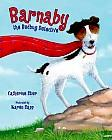 Author Catherine Stier read about rescue shelter dogs that were trained to become super-sniffing, bedbug detecting dogs, and it planted the seed for the story of Barnaby. Barnaby is a shelter dog who dreams of being a hero. However, he is continually overlooked for adoption as the people who come to the shelter choose quieter dogs. Then one day, Martha chooses Barnaby for her new companion and sends him to a school where they train him, and Martha as his handler, to be a bedbug detective dog. Upon graduation, Martha and Barnaby get jobs in a movie theater and hotels and even people’s homes. Narrated by Barnaby, this tale weaves in actual facts about bedbugs and the final pages give more detailed information about infestation and facts about these invasive insects. For extra visual information, show this video from Animal Planet about these trained detective dogs.
Author Catherine Stier read about rescue shelter dogs that were trained to become super-sniffing, bedbug detecting dogs, and it planted the seed for the story of Barnaby. Barnaby is a shelter dog who dreams of being a hero. However, he is continually overlooked for adoption as the people who come to the shelter choose quieter dogs. Then one day, Martha chooses Barnaby for her new companion and sends him to a school where they train him, and Martha as his handler, to be a bedbug detective dog. Upon graduation, Martha and Barnaby get jobs in a movie theater and hotels and even people’s homes. Narrated by Barnaby, this tale weaves in actual facts about bedbugs and the final pages give more detailed information about infestation and facts about these invasive insects. For extra visual information, show this video from Animal Planet about these trained detective dogs.
- Karen Hildebrand, Ohio Library and Reading Consultant
GRADES 3-5
Funk, Joe. (2013). Mush! Sled dogs of the Iditarod. New York: Scholastic.
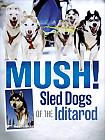 This photograph-filled book focuses on the 2012 Iditarod, the popular dog sled race. The opening ceremony kicked off in Anchorage, Alaska, with perfect weather for racing sleds. With 975 miles ahead, one man, Dallas Seavey, and his huskies headed off on a cold, lonely, and challenging journey to Nome, Alaska. This book starts with the story of the journey of 2012 Iditarod champion, Dallas Seavey, and provides the history of Iditarod trail sled dog race. Along the way, readers will experience vicariously the harshness of the race for both sled dogs and mushers (competitors). Readers are likely to come to admire those brave and intelligent huskies. This book shows readers how humans and dogs work together to overcome tough tasks. Dog-lovers and children will definitely enjoy reading about the bonds that develop between these humans and the dogs as they race for glory. The full-color photos of the sled dogs make the book even more appealing.
This photograph-filled book focuses on the 2012 Iditarod, the popular dog sled race. The opening ceremony kicked off in Anchorage, Alaska, with perfect weather for racing sleds. With 975 miles ahead, one man, Dallas Seavey, and his huskies headed off on a cold, lonely, and challenging journey to Nome, Alaska. This book starts with the story of the journey of 2012 Iditarod champion, Dallas Seavey, and provides the history of Iditarod trail sled dog race. Along the way, readers will experience vicariously the harshness of the race for both sled dogs and mushers (competitors). Readers are likely to come to admire those brave and intelligent huskies. This book shows readers how humans and dogs work together to overcome tough tasks. Dog-lovers and children will definitely enjoy reading about the bonds that develop between these humans and the dogs as they race for glory. The full-color photos of the sled dogs make the book even more appealing.
- Ying-Hsuan Lee, Washington State University Pullman
Goldish, Meish. (2013). Disabled dogs. New York: Bearport Press.
 Starting with the story of Faith, a young puppy born in 2002 with no front legs, and on to stories like Echo, a blind Australian shepherd, and to Angelyne, who is deaf, this book is full of information about how these brave dogs have overcome adversity of many sorts to lead healthy and happy lives. Some have gone on to become therapy dogs that help people. Beautiful but gripping photographs make these disabilities very real for young readers. Fact boxes throughout the text add to the information given for each disability. Vocabulary, glossary, index, additional reading and websites are provided at the end for further study.
Starting with the story of Faith, a young puppy born in 2002 with no front legs, and on to stories like Echo, a blind Australian shepherd, and to Angelyne, who is deaf, this book is full of information about how these brave dogs have overcome adversity of many sorts to lead healthy and happy lives. Some have gone on to become therapy dogs that help people. Beautiful but gripping photographs make these disabilities very real for young readers. Fact boxes throughout the text add to the information given for each disability. Vocabulary, glossary, index, additional reading and websites are provided at the end for further study.
- Karen Hildebrand, Ohio Library and Reading Consultant
Klimo, Kate. (2013). Buddy. Illus. by Tim Jessell. New York: Random House.
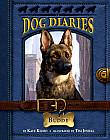 Based on a true story, Klimo tells the tale through the voice of German Shepherd, Kiss, being trained as a seeing-eye dog. Kiss is the first dog trained at Dorothy Eustis’s Seeing Eye Guide-Dog School for the Blind. Kiss knows she is bound for doing great things. She is being trained to take care of her trainer Jack, and when she is suddenly given away to take care of Morris, she doesn’t quite understand why her life is changing. Morris is so different from Jack, even wanting to change her name to Buddy. The author has included an ending chapter that discusses the care and training of the seeing-eye dog program and its history that also includes information about hosting guide-dog puppies.
Based on a true story, Klimo tells the tale through the voice of German Shepherd, Kiss, being trained as a seeing-eye dog. Kiss is the first dog trained at Dorothy Eustis’s Seeing Eye Guide-Dog School for the Blind. Kiss knows she is bound for doing great things. She is being trained to take care of her trainer Jack, and when she is suddenly given away to take care of Morris, she doesn’t quite understand why her life is changing. Morris is so different from Jack, even wanting to change her name to Buddy. The author has included an ending chapter that discusses the care and training of the seeing-eye dog program and its history that also includes information about hosting guide-dog puppies.
- Karen Hildebrand, Ohio Library and Reading Consultant
MacLachlan, Patricia. (2013) White fur flying. New York: Margaret K. McElderry Books/Simon and Schuster.
 Zoe Cassidy and her younger sister Alice are part of a loving family who takes care of Great Pyrenees rescue dogs. Zoe’s mother trains them, veterinarian father makes sure they are healthy, and then good homes are found for these white fur flying rescued dogs. This leaves behind the family pet, Kodi, also a Great Pyrenees, who misses his new friends once they are placed in new homes. One day a young boy named Phillip shows up at the home of their neighbors, and Zoe and Alice learn that Phillip has come to stay with his aunt and uncle while his parents work out some difficulties. Phillip won’t speak to anyone but slowly develops a relationship with Kodi, in addition to the other family pet, a brassy parrot named Lena. Phillip runs off one night during a terrible hailstorm chasing one of the new rescue dogs, Jack. The power of pets coupled with the power of the writing of Newbery-award winning author Patricia MacLachlan make this a quiet story of strength and survival.
Zoe Cassidy and her younger sister Alice are part of a loving family who takes care of Great Pyrenees rescue dogs. Zoe’s mother trains them, veterinarian father makes sure they are healthy, and then good homes are found for these white fur flying rescued dogs. This leaves behind the family pet, Kodi, also a Great Pyrenees, who misses his new friends once they are placed in new homes. One day a young boy named Phillip shows up at the home of their neighbors, and Zoe and Alice learn that Phillip has come to stay with his aunt and uncle while his parents work out some difficulties. Phillip won’t speak to anyone but slowly develops a relationship with Kodi, in addition to the other family pet, a brassy parrot named Lena. Phillip runs off one night during a terrible hailstorm chasing one of the new rescue dogs, Jack. The power of pets coupled with the power of the writing of Newbery-award winning author Patricia MacLachlan make this a quiet story of strength and survival.
- Karen Hildebrand, Ohio Library and Reading Consultant
GRADES 6-8
Gallico, Paul. (2013). The abandoned. New York: NYRB Classics.
 First published in 1950 by Knopf and also in the UK under the title of “Jennie,” this classic cat fantasy will still capture the attention of readers today. Eight-year old Peter is lonely. His mother is quite the socialite and is frequently attending society gatherings abandoning Peter to his nanny. Peter would love to have a cat but his nanny absolutely refuses to even consider the idea. When Peter is out for a walk one evening he watches as a truck is barreling down the street right in the path of a young cat. Peter dives in front of the truck to save the cat and the truck strikes him down. When Peter regains consciousness, he immediately realizes he is different. He has paws…and fur…and a tail! He has become a cat. He learns very quickly that life on the street for a cat is not easy. Fortunately, he meets Jennie—a very street savvy feline who teaches him the ways of the world from the cat’s point of view.
First published in 1950 by Knopf and also in the UK under the title of “Jennie,” this classic cat fantasy will still capture the attention of readers today. Eight-year old Peter is lonely. His mother is quite the socialite and is frequently attending society gatherings abandoning Peter to his nanny. Peter would love to have a cat but his nanny absolutely refuses to even consider the idea. When Peter is out for a walk one evening he watches as a truck is barreling down the street right in the path of a young cat. Peter dives in front of the truck to save the cat and the truck strikes him down. When Peter regains consciousness, he immediately realizes he is different. He has paws…and fur…and a tail! He has become a cat. He learns very quickly that life on the street for a cat is not easy. Fortunately, he meets Jennie—a very street savvy feline who teaches him the ways of the world from the cat’s point of view.
- Karen Hildebrand, Ohio Library and Reading Consultant
Korman, Gordon. (2013). Hideout. New York: Scholastic.
 As is almost always the case with this author, this fast-paced title is filled with humor and populated with interesting characters. In the fifth installment of his Swindle series, villainous S. Wendell Palomino, former owner of Luthor, a huge Doberman, is determined to get the dog back, use him in a moneymaking scheme, and then get rid of him. He claims that there is no paperwork that he actually gave up the dog to Savannah Drysdale who has adopted Luthor and taught him to embrace his inner gentleness. Savannah is understandably upset since she and Luthor share a special bond even while he still has trouble trusting anyone else. Since Griffin Bing and his five friends, including Savannah, are attending three different summer camps while Luthor is supposed to be returned to Palomino [the students call him Swindle], Griffin hatches a plan to keep the dog hidden and safe from his cruel former owner. Although things don't go according to plan, Griffin and his mates keep coming up with alternatives. Readers will enjoy how each of the youngsters takes a turn at taking the lead in this adventure. Although there are plenty of twists, turns, and coincidences and a villain with apparently no redeeming qualities, the book is filled with humorous moments that will appeal to anyone who roots for the underdog--even when he weighs 150 pounds. This would be a great read aloud.
As is almost always the case with this author, this fast-paced title is filled with humor and populated with interesting characters. In the fifth installment of his Swindle series, villainous S. Wendell Palomino, former owner of Luthor, a huge Doberman, is determined to get the dog back, use him in a moneymaking scheme, and then get rid of him. He claims that there is no paperwork that he actually gave up the dog to Savannah Drysdale who has adopted Luthor and taught him to embrace his inner gentleness. Savannah is understandably upset since she and Luthor share a special bond even while he still has trouble trusting anyone else. Since Griffin Bing and his five friends, including Savannah, are attending three different summer camps while Luthor is supposed to be returned to Palomino [the students call him Swindle], Griffin hatches a plan to keep the dog hidden and safe from his cruel former owner. Although things don't go according to plan, Griffin and his mates keep coming up with alternatives. Readers will enjoy how each of the youngsters takes a turn at taking the lead in this adventure. Although there are plenty of twists, turns, and coincidences and a villain with apparently no redeeming qualities, the book is filled with humorous moments that will appeal to anyone who roots for the underdog--even when he weighs 150 pounds. This would be a great read aloud.
- Barbara A. Ward, Washington State University Pullman
Paulsen, Jim and Gary. (2013). Road trip. New York: Wendy Lamb Books.
 Veteran author Gary Paulsen has teamed up with his son, Jim, to write a book about a father and son road trip. Sounds like a writing match made in dog heaven. The story opens with Dad and 14-year-old Ben heading out to an animal shelter to rescue a border collie. Grudgingly, narrator Ben is going along as is the family dog, Atticus, who actually narrates parts of the trip at the end of Ben’s chapters. As the journey moves along and Ben has learned his father quit his job which means he can’t go to summer hockey camp, things seem to go downhill from there. They pick up quite an assortment of additional travelers including a questionable friend of Ben’s, a waitress who is running away from life but would like to become an actress, and Gus, an auto mechanic they pick up along with a school bus. From a race with the cops, a car fire, and a strange criminal chasing them and all the while trying to document it all on Facebook, this adventure has moments of family discord, canine insight and hilarity that middle school readers will enjoy. Teachers will appreciate the backstory in this interview with Gary and Jim Paulsen with Publisher’s Weekly.
Veteran author Gary Paulsen has teamed up with his son, Jim, to write a book about a father and son road trip. Sounds like a writing match made in dog heaven. The story opens with Dad and 14-year-old Ben heading out to an animal shelter to rescue a border collie. Grudgingly, narrator Ben is going along as is the family dog, Atticus, who actually narrates parts of the trip at the end of Ben’s chapters. As the journey moves along and Ben has learned his father quit his job which means he can’t go to summer hockey camp, things seem to go downhill from there. They pick up quite an assortment of additional travelers including a questionable friend of Ben’s, a waitress who is running away from life but would like to become an actress, and Gus, an auto mechanic they pick up along with a school bus. From a race with the cops, a car fire, and a strange criminal chasing them and all the while trying to document it all on Facebook, this adventure has moments of family discord, canine insight and hilarity that middle school readers will enjoy. Teachers will appreciate the backstory in this interview with Gary and Jim Paulsen with Publisher’s Weekly.
- Karen Hildebrand, Ohio Library and Reading Consultant
GRADES 9-12
Northrop, Michael. (2013). Rotten. New York: Scholastic.
 After a summer spent away from home, Jimmer (JD) Dobbs returns to his friends but still holds onto the secret behind his absence even while they seem to know where he's really been. He's desperate to reconnect with his ex-girlfriend, but since he's been incommunicado for the whole summer, that's not going to be easy. Things are a little different at home too. His mother has taken in a rescued Rottweiler who fears men due to his own mistreatment. Surprisingly, JD bonds with the dog, who he renames Johnny Rotten after one of his musical influences. Although JR has a fierce bark and can't stand to be cornered, he slowly learns to trust JD and some of the others in his life. After Mars, one of JD's friends, corners him, the dog bites him. Mars lies about what happened, and his family concocts a plot to sue JD's family and have the dog put down. Readers will worry about JR's fate for much of the book while also enjoying the way he starts to become a very good dog. Throughout the book's pages, readers will reflect on how the cruelty and mistakes of others have made JR fearful and brought him to this particular point as well as how JD’s own mistakes have led to his own particular turning point. The connections between the boy and the dog are described quite well without becoming too maudlin for the tastes of teen readers. Additionally, the author creates complex characters that force readers to reconsider how they regard Mars and Aaron, JD’s classmate who seems to have everything he could ever want, but who turns out to have a dog-related secret in his past.
After a summer spent away from home, Jimmer (JD) Dobbs returns to his friends but still holds onto the secret behind his absence even while they seem to know where he's really been. He's desperate to reconnect with his ex-girlfriend, but since he's been incommunicado for the whole summer, that's not going to be easy. Things are a little different at home too. His mother has taken in a rescued Rottweiler who fears men due to his own mistreatment. Surprisingly, JD bonds with the dog, who he renames Johnny Rotten after one of his musical influences. Although JR has a fierce bark and can't stand to be cornered, he slowly learns to trust JD and some of the others in his life. After Mars, one of JD's friends, corners him, the dog bites him. Mars lies about what happened, and his family concocts a plot to sue JD's family and have the dog put down. Readers will worry about JR's fate for much of the book while also enjoying the way he starts to become a very good dog. Throughout the book's pages, readers will reflect on how the cruelty and mistakes of others have made JR fearful and brought him to this particular point as well as how JD’s own mistakes have led to his own particular turning point. The connections between the boy and the dog are described quite well without becoming too maudlin for the tastes of teen readers. Additionally, the author creates complex characters that force readers to reconsider how they regard Mars and Aaron, JD’s classmate who seems to have everything he could ever want, but who turns out to have a dog-related secret in his past.
- Barbara A. Ward, Washington State University Pullman
These reviews are submitted by members of the International Reading Association's Children's Literature and Reading Special Interest Group (CL/R SIG) and are published weekly on Reading Today Online. The International Reading Association partners with the National Council of Teachers of English and Verizon Thinkfinity to produce ReadWriteThink.org, a website devoted to providing literacy instruction and interactive resources for grades K–12.